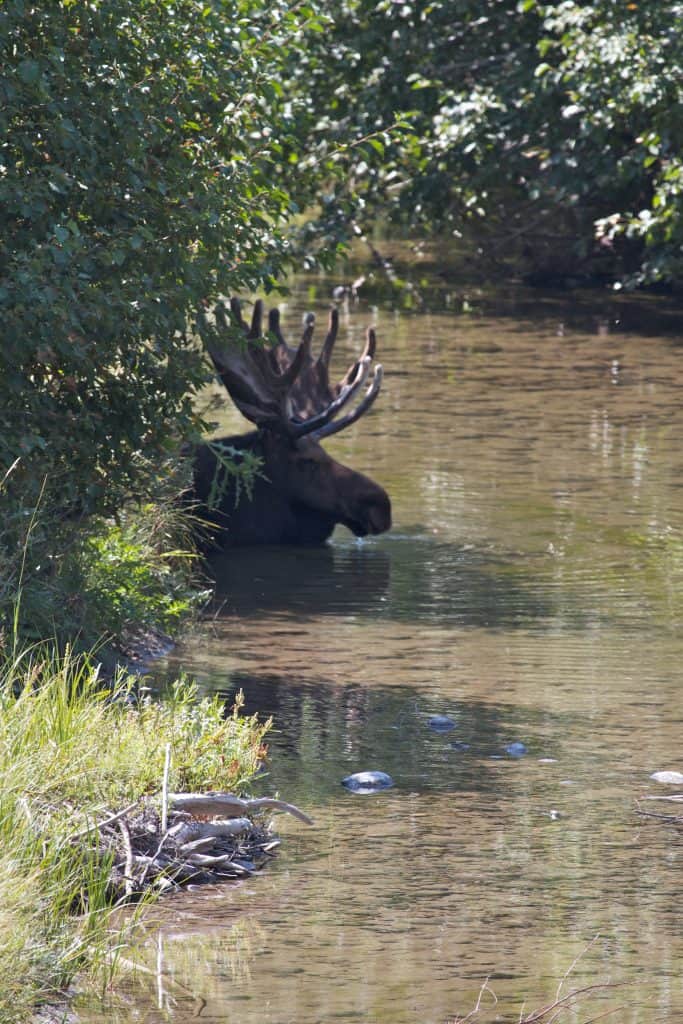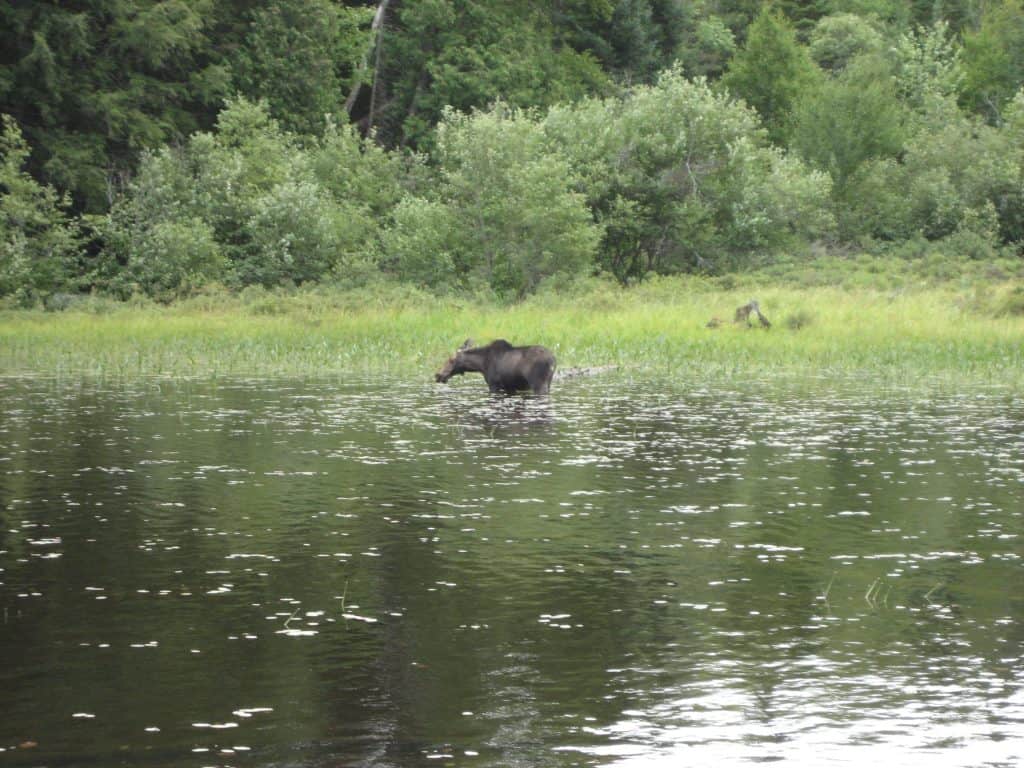
Written by Stephen Ondich
Moose are closely associated with the state of Maine. When people visit Maine, they often go to Acadia National Park on Mount Desert Island. Thus, it follows that park visitors frequently expect to encounter moose. Moose are gentle giants (usually).
↓ Subscribe to Our YouTube channel NOW ! ↓

My First Maine Trip
The first time I visited Maine, I really wanted to encounter a moose in the wild. However, I did no research and had little knowledge of them. They were large and in Maine. Hence, I thought we would just spot one randomly. Ultimately, we did see a few but they were in the friendly confines of The Maine Wildlife Park in Grey, Maine. I didn’t really need my tripod for that. It is definitely worth a stop but not exactly what I had in mind.
Moose as the Maine State Animal
In 1979 the state of Maine officially made the moose its state animal. According to Hunting in the USA, Maine has the highest density of population in the continental United States.
These massive creatures can reach a height of over 6 feet and a weight of over 1400LB. If spooked, they can run at speeds of up to 35 miles per hour! Before getting too close to a wild one, keep that in mind. Being run down by an animal of that size is a scary proposition. If I had to choose between facing down a Prius or a charging adult moose on Park Loop Road, I’d have to think about it!
With their distinctive muzzle, long dense brown fur and impressive build, they stand out in the wild. They are just too big to hide.
Are there Moose in Acadia National Park?
Visitors to Acadia National Park frequently ask park officials if they are likely to spot a moose on their trip. According to supervisory Park Official Betty Lyle, in twenty years of living on Mount Desert Island, she has yet to see one. Of course, she said this back in 2012. Perhaps her luck has changed in the last five years.
There are occasional moose sightings in Acadia but they seem to be the exception rather than the rule.
According to Acadia National Park Biologist Bruce Connery, the moose that find their way onto Mount Desert Island are often disoriented.
Alternatively, some of island dwelling moose suffer from brain worm (it’s every bit as horrific as it sounds) which causes damage to the central nervous system resulting in unpredictable behaviors. Often, this means the afflicted animal just wanders aimlessly in a zombie-like state, typically in circles. However, in some cases it leads them into Acadia National Park, an area that they are not typically drawn to.
Animals That Are in Acadia National Park
Here are ten animals that you are more likely to encounter inside of Acadia National Park than moose. Of course, sightings still depend on animal migration patterns, park temperatures, and sometimes just luck.
- Song Birds – “In a tree by the brook, there’s a Song Bird that sings…” Comment below if sometimes all of your thoughts are misgiving.
- Peregrine Falcons – This distinctive bird is the largest falcon in North America. They are masterful hunters and are often found along the coastal regions of Acadia National Park.
- Sandpipers – These shore birds feed near the coast.
- Harlequin Ducks – Harlequin Ducks have interesting colors. More than half of their total North American population is concentrated in the coastal areas of Maine. They are very easy to spot in Acadia.
- Otters – Otters are an important part of Acadia’s ecosystem. When otters are plentiful, things are good.
- Foxes – Check out these two snoozing Red Foxes in Acadia. Black, Red and Silver Foxes are found throughout the park.
- Deer – Deer are the most common mid-size animal in the park.
- Dolphin – Like moose, spotting dolphin is hit or miss. They do appear off the coast but are underwater most of the time. The best month to see dolphin is May.
- Seals – Head just outside of the park and take a cruise on Frenchmen’s Bay to spot seals sunning themselves on Maine’s rugged ocean coastline.
- Whales – Whale watching season in Acadia takes place from mid-April through October.
For a full breakdown of animal species in Acadia, check out the National Park Service’s online specie directory here. You can either browse the directory or search by name.

What Type of Habitats Do Moose Like?
Due to their size, moose have difficulty surviving in locations that exceed 80 Fahrenheit in temperature. Often, when temperatures rise during the summer months, they will immerse themselves in water to stay cool.
Accordingly, moose gravitate toward areas that receive snow cover in winter, are wooded, and have many streams, lakes, or other water sources which they can wade into to regulate their temperature.
Typically in Maine, these locations are found inland. Unfortunately for moose-seekers, Maine’s coastal areas tend to be warmer than the higher elevations inland.
If you want to find moose in Maine, head toward ski resorts instead of beach resorts.
Best Places to Find Moose in Maine
To increase your chances of seeing a moose in the wild, you should expand your search radius outside of Acadia National Park.
Here are some of the best places in Maine to spot a wild one.
- Baxter State Park
- The Forks Region
- Lily Bay State Park
- Carrabassett Valley
- Rangeley Lake State Park
- Aroostook State Park
Moose Spotting Tips
Whether you are in Acadia National Park or further inland, there are steps you can take to increase the chances of seeing a wild moose.
- Search during the optimal sighting months. They are most active from May through July and then Fall.
- Focus your search efforts on the early morning and dusk hours. Moose tend to lay low during the middle of the day
- Stay close to bogs and wetlands. These are the places that they tend to congregate. Remember, they need a water source in order to regulate their internal temperature.
- Take a guided moose tour. Yes, there are tours you can take. Of course, no one can guarantee a sighting in the wild. Local professionals (at least the successful ones) know how to find them pretty consistently. A guided tour may be worth the investment especially if you rarely come to Maine.
- Protect yourself from ticks. If you venture into wet wooded areas, you may encounter ticks before moose. Deer Ticks spread Lyme Disease so take precautions. The itch from a tick bite is a minor annoyance but Lyme Disease is a serious health issue.
- Visit the Maine Wildlife Park. If you fail to see a wild specimen at any of these locations, you can always head over to The Maine Wildlife Park. The moose is a spectacular animal. Although it’s not quite as fun to spot one inside a fenced area as it is in the wild, the experience is still memorable.
Heidi
13 Mar 2019Thanks for the helpful article. Now I understand why we’ve never seen a moose when we are visiting Maine’s coast.
Stephen
13 Mar 2019At least now you know where to look! Head inland on your next trip!
Pingback: Is Acadia National Park Open During Winter? - Maine Terrain - 2019
Steve
26 Mar 2019I want to see a moose next time!
Pingback: Glamping Near Acadia National Park - Maine Terrain - 2019
Pingback: Milbridge, Maine: A Helpful Guide - Maine Terrain
Pingback: What Size is a Moose? - Maine Terrain
Pingback: 🌄Drone's Eye View: Ryan Malagara films Down East -Maine Terrain-2019